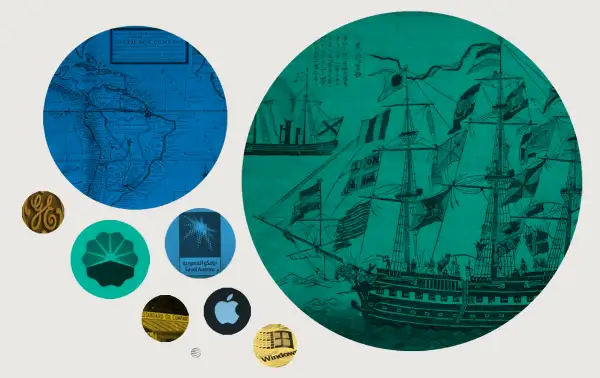Apple Isn't the First to Hit $1 Trillion In Value. Here Are 5 Companies That Did It Earlier
Money is not a client of any investment adviser featured on this page. The information provided on this page is for educational purposes only and is not intended as investment advice. Money does not offer advisory services.

Apple’s status as a cultural icon has just reached a new level. Now that the tech giant's stock is trading above $207.04 a share, Apple is being hailed today as the first $1 trillion company, based on the total value of its stock.
But is it really?
If you just look at American companies today, it may look that way. In the S&P 500 index of the biggest U.S. stocks, Apple sits comfortably atop the list with a $1 trillion market value, followed by Amazon.com at $872 billion, Google-parent Alphabet at $844 billion, Microsoft at $816 billion, and Facebook at $504 billion.
But when you expand your search and start to look globally and historically, you'll find plenty of examples of dominant corporations that actually dwarf Apple’s market size — after you inflation-adjust their value to today's dollars to make a fair comparison.
If you do that, Apple is just one of several dominant companies that crossed the equivalent of the $1 trillion threshold.
How Does Apple Stock Stack Up to History's Biggest Companies?
Dutch East India Co.
Industry: Global Trade
Value in Today's Dollars: $8.2 Trillion
The Dutch East India Co. has been dubbed the world's first multinational.
At the end of the 16th century, Dutch ships set sail to South and East Asia to bring spices such as cloves and nutmeg and luxury goods back to Europe. Demand for — and profits from — such goods was so strong that Dutch shippers recognized the value of joining forces, leading to the creation of the Vereenigde Oost-Indische Compagnie, or the United East India Company (or outside of the Netherlands, the Dutch East India Co).
Much of the company's wealth derived from the monopoly status it was granted by the government for all Dutch trade in Asia. And compounding those profits was the boom in the trade of tulip bulbs, whose prices soared in the 1630s. 'Tulip Mania' is not only considered history's first true financial bubble, it is regarded as one of the biggest bubbles ever — ranking up there with Internet stocks in the 1990s and real estate in the mid 2000s.
With full control of trade in Asia and the tulip craze, which ended in a disastrous crash, the company's overall market value reached 78 million Dutch guilders in the early 1600s, according Alex Planes, writing for Motley Fool. That equates to roughly $8.2 trillion today.
South Sea Co.
Industry: Global Trade
Value in Today's Dollars: $4 Trillion
South Sea Co. positioned itself as a British-version of the Dutch East India Co. in the 1700s. But instead of contributing to a bubble (in the trade of tulip bulbs), South Sea was the bubble itself.
Dubbed by modern analysts as the “Enron of England,” South Sea Co. marketed itself as a promising investment because it enjoyed a trading monopoly with Mexico and South American nations. It was granted that monopoly by the British government in exchange for helping to finance the government's debt, amid war with Spain.
Trouble is, Spain controlled many of those South American trading posts, and the Treaty of Utrecht, which ended that war, left Spain firmly in control of those territories, rendering the South Sea Co.'s "monopoly" meaningless.
That didn't stop the company's leaders from making false claims of trade riches, which sent the stock of South Sea Co. soaring in a classic bubble, reaching a peak value in today's dollars of around $4 trillion. But by the time the fraud was discovered and the bubble burst, the leaders of the company had sold their stakes.
PetroChina
Industry: Oil Exploration and Production
Value in Today's Dollars: $1.7 Trillion
In the early 2000s, as the global financial markets were recovering from the dotcom crash, two things started to surge — oil prices, which went from $20 a barrel in 2002 to around $140 a barrel by 2008, and the Chinese economy and stock market.
By the time PetroChina, China's largest oil company, listed on the Shanghai Stock Exchange, the company surpassed ExxonMobil as not only the biggest oil company, but the most valuable corporation at the time.
Speculation in Chinese stocks and oil drove PetroChina beyond $1 trillion market value, eventually reaching $1.7 trillion based on today's dollars. Of course, that was right around the time of the global financial crisis, after which oil prices collapsed, Chinese stocks plunged, and PetroChina shares have since lost over $800 billion in market value.
Saudi Aramco
Industry: Oil Exploration and Production
Value in Today's Dollars: $1.5 Trillion
Even if you just focus on today's most valuable companies, Apple still can't claim to be the biggest in the world.
That distinction goes to another monopoly — Saudi Aramco, the state-owned oil company of Saudi Arabia, which is the top global exporter of
The company is built on the oil holdings of one of the highest-oil-producing nations in the world. With a planned initial public offering by early next year, Saudi Aramco is valued at $1.5 trillion right now, making it about 50% larger than Apple.
Standard Oil
Industry: Oil Exploration and Production
Value in Today's Dollars: $1 Trillion
It wasn't that long ago when ExxonMobil, and not Apple, was the most valuable company in the United States.
Yet what constitutes ExxonMobil today was just a small part of a much larger energy giant more than a century ago. Before 1911, when the government ordered its breakup, John D. Rockefeller's Standard Oil was the largest company in the country.
To understand how large Standard Oil was, imagine ExxonMobil, Chevron, parts of BP and Marathon Petroleum all in one company. That’s essentially Standard Oil before the Sherman Antitrust Act forced the monopoly to unwind.
Estimates pinpoint a $1 trillion market cap if Standard was reassembled today.
Microsoft
Industry: Technology
Value in Today's Dollars: $930 billion
Today, Microsoft is thought of as "old tech" — in other words, it's seen as an industry leader that delivers reliable profits but that's expected to grow much slower than "new tech" leaders like Amazon, Netflix, Facebook, and even Apple.
But investors who came of age after the dotcom crash may not realize that in the 1990s, Microsoft was the leader and Apple was the laggard. In fact, from 1990 to 1999, Microsoft shares gained nearly 10,000%, versus just 133% for Apple.
In that historic run-up during the tech bubble craze, Microsoft's market value skyrocketed to about $613 billion. Adjusted for inflation, that's roughly $930 billion in today's dollars, which puts it fairly close to Apple's level now.
General Electric
Industry: Industrial
Value in Today's Dollars: $911 billion
It's hard to remember, now that General Electric has run into hard times, having lost nearly half its value over the past year.
But much in the same way as Microsoft, GE’s market value ballooned in the late 1990s, growing to $600 billion by 2000. That equates to $911 billion today.
Of course, in real dollars, GE’s price has never recovered from the 2008 recession, giving it a market cap of around $130 billion, 78% below its 2000 mark.
